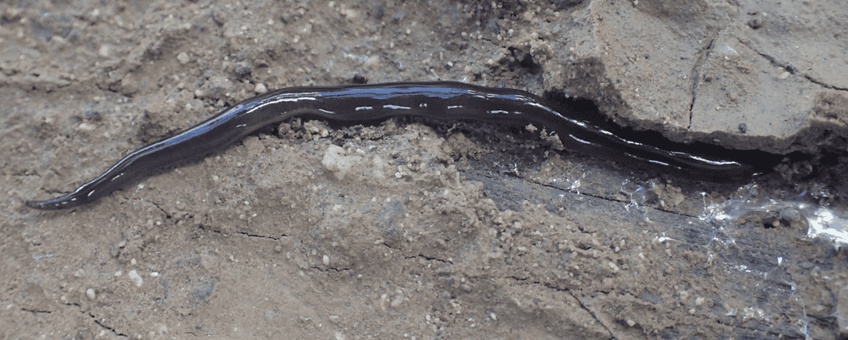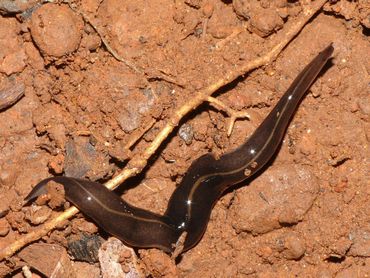
Team Snail finds invasive land flatworm on Bonaire
Dutch Caribbean Nature Alliance (DCNA), Naturalis Biodiversity CenterAt the beginning of 2023, STINAPA and Naturalis Biodiversity Center conducted a major study of invertebrates on the island of Bonaire, a group that has so far been under examined. Sylvia van Leeuwen, snail expert from Naturalis, did two weeks of field work at various locations with Team Snail. That was very successful: twenty new species could be added for this island.

Many snails like moist, dark places, and if you search there, you will of course also come across all kinds of other soil fauna, such as worms and woodlice. “Usually you ignore that,” says Sylvia, “but I was triggered by a fairly large, dark flat worm, which I had not seen before and which was certainly not an earthworm. It rang a bell: this had to be a land flatworm. I photographed it and collected it so that land flatworm taxonomist Sytske de Waart from Naturalis could identify it.” Sytske confirmed the identification: unfortunately, it turned out to be the invasive New Guinea flatworm (Platydemus manokwari).
A too effective predator
Unfortunately, because it is considered one of the hundred most harmful invasive exotic species in the world by the IUCN. It is an effective predator that can pose a serious threat to native land snails. The terrestrial flatworms follow the slime trail of snails, slide over the shell and body and enter the snail through the breathing opening where they feast on the internal organs. The New Guinea flatworm can even handle prey larger than itself if there are many of them. Experiments have shown that the land flatworm eats not only snails that live on the ground, but also snails on tree trunks. And it is particularly effective at that.
“Land flatworms are carnivores, and most species eat small soil animals such as snails and earthworms,” says Sytske de Waart, “so this one is no different in that respect. However, we know from the past that things can go terribly wrong if he is introduced on an island as an exotic animal. In the 1960s it was thought that it was a good idea to use the New Guinea flatworm as a biological control of the African giant snail on a number of islands in the Pacific Ocean. He did this very effectively, and then turned to the native snails. These introductions are considered a major cause of the extinction of native land snails on several Pacific islands.”
Sylvia adds: “Among land snails, island snails are among the most vulnerable group. The land snail fauna of Bonaire also consists largely of endemic island species. Eight of the 31 (sub)species of land snails now known from Bonaire occur only there and one species only occurs on Bonaire and Curaçao, and nowhere else in the world. This makes these species extra vulnerable.”

Measures are necessary
The introduction of the New Guinea flatworm could therefore pose a serious risk to the conservation of Bonaire’s unique land snail fauna. And not only on Bonaire, they have also been found on several other Caribbean islands.
How do they get there? Land flatworms hitch a ride with the international pot plant trade. The location where Sylvia found them confirms this: in and around two garden centers. The garden plants on Bonaire are mainly imported from Florida and Dominica. The New Guinea flatworm also occurs in Florida, so this route makes sense. Fortunately, the New Guinea flatworm has not yet been found in the Washington Slagbaai National Park.
To prevent further spread, the existing populations of this land flatworm should be controlled on Bonaire. “However, do not touch the flatworms with your bare hands,” Sylvia warns. “This land flatworm can carry a rat lungworm (Angiostrongylus cantonensis) that can cause encephalitis or meningitis in humans.” But preventing the flatworms from reaching the island is of course better than trying to control existing populations. “We recommend taking more measures to prevent the introduction of exotic species via potted plants on Bonaire,” say Sylvia and Sytske. “And we also call on everyone to report finds of land flatworms, for example via Observation.org. That way we can monitor the distribution.”
Text: Sytske de Waart and Sylvia van Leeuwen, Naturalis Biodiversity Center
Photos: Sylvia van Leeuwen; Shinji Sugiura; Tello Neckheim
